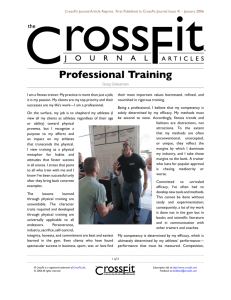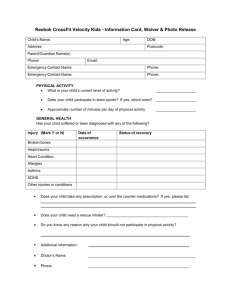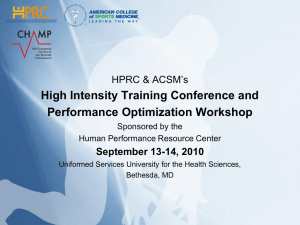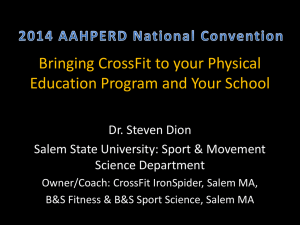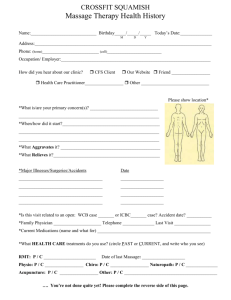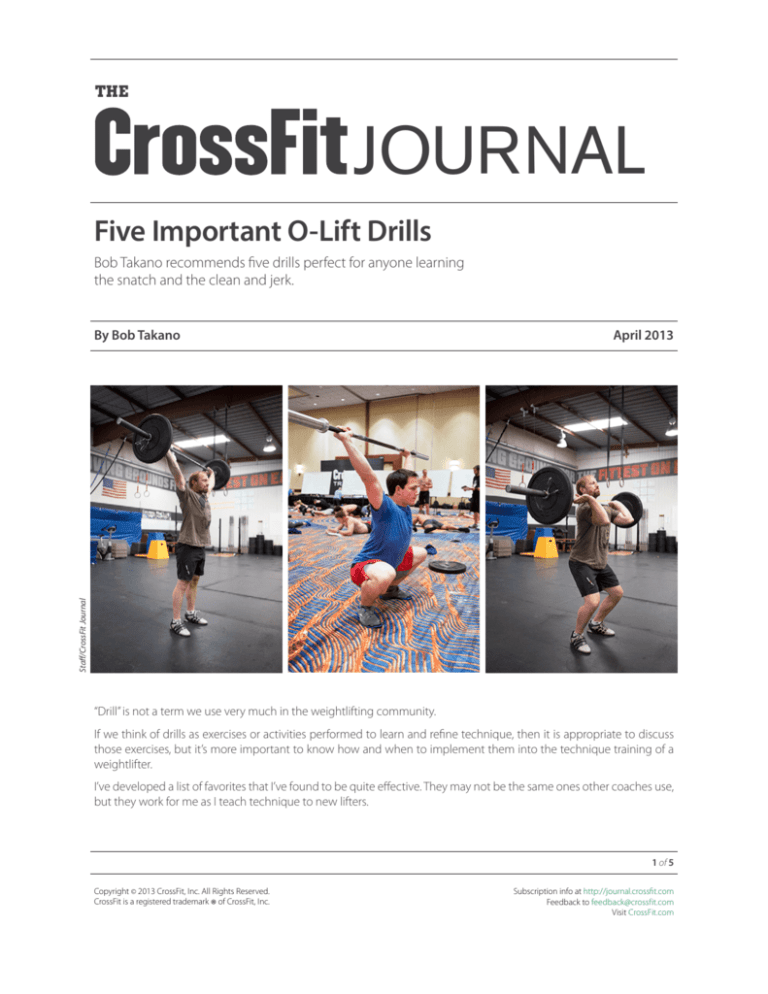
THE
JOURNAL
Five Important O-Lift Drills
Bob Takano recommends five drills perfect for anyone learning
the snatch and the clean and jerk.
April 2013
Staff/CrossFit Journal
By Bob Takano
“Drill” is not a term we use very much in the weightlifting community.
If we think of drills as exercises or activities performed to learn and refine technique, then it is appropriate to discuss
those exercises, but it’s more important to know how and when to implement them into the technique training of a
weightlifter.
I’ve developed a list of favorites that I’ve found to be quite effective. They may not be the same ones other coaches use,
but they work for me as I teach technique to new lifters.
1 of 5
Copyright © 2013 CrossFit, Inc. All Rights Reserved.
CrossFit is a registered trademark of CrossFit, Inc.
®
Subscription info at http://journal.crossfit.com
Feedback to feedback@crossfit.com
Visit CrossFit.com
(continued)
Staff/CrossFit Journal
Important ...
The jerk balance teaches athletes to keep the torso erect and drive forward under the bar.
I’m going to digress a bit here and address the issue of
exercise selection by coaches. It is perfectly natural and
normal for many coaches to address their own shortcomings or strengths while designing training, especially
during the early days of the coaching career. Coaches
who had poor lockout may have their athletes training
to improve lockout even when it’s unnecessary to do so.
On the other hand, there might be coaches who were
excellent pullers and so design training that overemphasizes pulling. Both extremes are incorrect. Coaches mature
when they learn to solve the shortcomings of each athlete
they are coaching.
Now, on to my selections. I wouldn’t call these essential,
but I do use these movements most frequently, so I believe
they apply to the most universal shortcomings. The
number of times they are employed in training is strictly
individual.
Jerk Balance
Many athletes find it difficult to conceptualize supporting
a weight directly overhead and stepping forward into a lift
to do so. This movement helps to remediate that situation,
which is particularly prevalent with people who have a
strong bench-pressing background. There are two reasons
for this:
1. Their shoulder mobility is often limited so overhead
support is difficult.
2. They’re used to looking up at the bar they’re lifting,
which causes a bending of the torso away from the
line of support.
The first variation of the jerk balance is to perform the
movement with the bar resting on the shoulders behind
the neck. This will make it easier to position the bar directly
overhead. The feet should be positioned with the lead foot
approximately 30 centimeters ahead of the hind foot. The
hind food should be balanced on the ball of the foot with
the toes pointed inward or straight ahead.
The movement commences with the athlete bending the
knees to dip and then driving up so that the bar is driven
overhead. At the peak of the leg drive, the front foot steps
forward into a standard lunging distance and the bar
should travel upwards to a locked-arm position.
When this exercise becomes comfortable and the athlete
is familiar with the finishing position, the movement can
then be practiced with the bar resting on the shoulders
in front of the neck. The same movement pattern and
dynamic are employed, but this version places more stress
on the torso to maintain an erect position and is more
similar to the actual jerk. It also forces the shoulders into the
most proper position of overhead support. Furthermore, it
places an emphasis on maintaining a rigid torso during the
drive, drop and overhead-locking phases. It also teaches
the athlete to push forward off the back foot, the lack of
which is often a cause for jerks being lost forward.
2 of 5
Copyright © 2013 CrossFit, Inc. All Rights Reserved.
CrossFit is a registered trademark of CrossFit, Inc.
®
Subscription info at http://journal.crossfit.com
Feedback to feedback@crossfit.com
Visit CrossFit.com
Important ...
(continued)
Four sets of 2 to 4 reps at appropriately taxing weights are
prescribed.
Halting Deadlifts
The snatch and clean variations of this movement are both
exceptionally valuable for teaching the most difficult phase
of the pull, and they can also be employed throughout the
training of the athlete to increase strength in the correct
motor pathway once technique is mastered. Halting
deadlifts should be employed early in the techniquetraining process in sets of 2, 3 or 4 reps per set with a
weight that taxes the weakest muscles employed in that
particular phase.
The first variation is the halting deadlift to the knees. This
phase teaches the simultaneous rising of the shoulders
and hips until the bar reaches knee height, where it is
stopped for 3 seconds on each rep. An emphasis should
be placed on “pushing the floor down with the feet” and
keeping the bar close to the body by forcibly contracting
the latissimus dorsi muscles. Coach the athlete to
perform this movement as slowly as is necessary to
maintain form. Doing so will teach the rippers to learn to
control the first pull.
The second variation is to continue further and lift the bar
to the power position. This requires performing the first
variation correctly, and then shifting the knees and hips
forward while slightly extending the hips and keeping
the shoulders over or ahead of the bar. Simultaneously,
the pressure on the foot shifts from the front of the heel
to the ball of the foot. The latissimus dorsi are extremely
important in maintaining the proper angle between the
torso and the arms.
After the first variation is mastered, the second variation
should be practiced until it is performed nearly perfectly.
From this point of accomplishment, the lifter is ready to
proceed to learning the entire pull.
Push Press
Although at first glance the push press appears to be a
pressing movement, it is actually a jerk-driving movement.
If sufficient jerk drive does not propel the bar above the top
of the head, the pressing portion cannot be completed.
Staff/CrossFit Journal
The shoulders should remain above or in front of the bar.
The pressure on the foot goes from the ball of the foot
to the front of the heel. Some athletes may have seen
world-class athletes starting with a low hip position and
then raising the hips to a more conventional starting
position in an attempt to generate more momentum
early in the first pull. This is an advanced technique and
should not be attempted until the conventional first pull
is thoroughly mastered and the physical development is
balanced.
The push press develops driving power in the legs and pressing strength in the arms.
Notice the bar is supported on the shoulders in Frame 1, allowing the legs to transfer momentum through the torso to the bar.
3 of 5
Copyright © 2013 CrossFit, Inc. All Rights Reserved.
CrossFit is a registered trademark of CrossFit, Inc.
®
Subscription info at http://journal.crossfit.com
Feedback to feedback@crossfit.com
Visit CrossFit.com
Important ...
(continued)
The bar must be supported on the shoulders so that the
shoulders and torso are supporting the weight, and not
the wrists and forearms. The elbows must be raised to the
front sufficiently to prevent the bar from rolling off the
shoulders. The knees should be unlocked.
The athlete bends the knees, keeping the torso erect, with
the pressure on the heels. The knees bend until powerposition depth is reached, and then the athlete drives
upward by extending the knees and hips until both are
straight. This should provide enough momentum to drive
the bar above head height. At this point the arms and
shoulders begin pressing the weight to a locked position
overhead.
Four to 5 sets of 2 to 4 reps should work well. After its use
during the technique-learning phase, the athlete can
continue to use the push press in training to develop jerkdriving power and pressing strength.
Muscle Snatch
Much emphasis is often given toward pulling the athlete
under the bar in the completion of the full snatch, but little
attention is given to the role of the arms in aligning the
body under the bar. Great snatches are also the result of
the lifter pushing the body under the bar once the bar
has reached a sufficient relative height. Most experienced
lifters will tell you that they achieved the lowest squat they
ever got into by pushing themselves lower off the bar
while performing a snatch.
The correct pathway for pushing under the bar in the
snatch is learned by performing muscle snatches, either
from the floor or the hang.
The pull is the same as for a typical power snatch, but once
full extension is reached, the knees do not re-bend. The
torso remains erect, and the elbows come from a pulling
position forward to a pressing position. The movement is
completed by pressing the weight overhead without any
lowering of the torso. This pressing movement is the one
that is employed to push the body under the bar at the
bottom of a squat snatch.
Staff/CrossFit Journal
Four sets of 2 to 4 reps are recommended. Although not
used extensively in advanced training, the muscle snatch
is an excellent warm-up movement for top-level lifters.
Practicing a muscle snatch during your warm-up
will drill correct arm positioning and help you practice
aligning your body underneath the barbell.
4 of 5
Copyright © 2013 CrossFit, Inc. All Rights Reserved.
CrossFit is a registered trademark of CrossFit, Inc.
®
Subscription info at http://journal.crossfit.com
Feedback to feedback@crossfit.com
Visit CrossFit.com
(continued)
Staff/CrossFit Journal
Important ...
Notice the position of the athlete’s torso remains unchanged, even as the bar travels overhead.
Snatch-Grip Squat Press
This movement forces athletes to sit more upright in the
overhead-squat position, allows them to position the
shoulders so that they can press under the weight, and
teaches the stabilization of the scapula by contracting the
rhomboids. All of these three aspects must be mastered in
order to become a proficient snatcher.
In the art of coaching, one of the truly important skills is
knowing when not to use an exercise. If these exercises
perform the functions they’re supposed to, they may have
to be de-emphasized in the continuing development of
the athlete. Figuring out the degree of de-emphasis is one
of the important tasks of the coach.
F
Some athletes with tight hip flexors may have a difficult time
maintaining an erect torso while overhead squatting. Others
have tight hamstrings, weak gluteals, weak spinal erectors or
any combination of these conditions. The snatch-grip squat
press will force all these situations to improve.
Four sets of 3 to 5 reps will work well, especially if performed
before snatching. This exercise is not a Sots press. Sots
presses are performed from in front of the neck with a cleanwidth grip and serve an entirely different set of functions.
Know When to Move On
Well, there you have them: my five favorite drill exercises
for beginners learning the technique of the snatch and
clean and jerk.
Marta Takano
The athlete should support the weight on the shoulders
behind the neck and take a snatch-width grip. Squat
into a flat-footed bottom position and commence the
movement by pressing the weight overhead while
staying in the squat. If an erect torso is not maintained,
the movement is difficult if not impossible to perform. If
the athlete does not know how to contract the rhomboids
to stabilize the scapulae, the arms cannot be placed in a
position to press the weight overhead.
About the Author
Bob Takano has developed and coached some of the best
weightlifters in the U.S. for the past 39 years. A 2007 inductee
into the U.S.A. Weightlifting Hall of Fame, he has coached four
national champions, seven national record holders and 28 top
10 nationally ranked lifters. Fifteen of the volleyball players he’s
coached have earned Division 1 volleyball scholarships. His
articles have been published by the NSCA and the International
Olympic Committee and helped to establish standards for the
coaching of the Olympic lifts. He is a former member of the
editorial board of the NSCA Journal, and an instructor for the
UCLA Extension program. He is currently the chairperson of the
NSCA Weightlifting Special Interest Group. He is a member of
Mike Burgener’s seminar team for the CrossFit Olympic Lifting
Trainer Course.. Website: www.takanoathletics.com.
5 of 5
Copyright © 2013 CrossFit, Inc. All Rights Reserved.
CrossFit is a registered trademark of CrossFit, Inc.
®
Subscription info at http://journal.crossfit.com
Feedback to feedback@crossfit.com
Visit CrossFit.com

